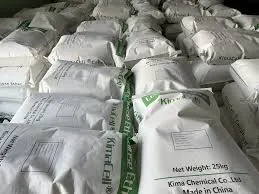
Dec . 13, 2024 06:02 Back to list
hydroxyethyl cellulose solubility in water
Introduction to Hydroxyethyl Cellulose and Its Solubility in Water
Hydroxyethyl cellulose (HEC) is a non-ionic, water-soluble polymer derived from cellulose, a natural polysaccharide found in plant cell walls. This important compound belongs to the family of cellulose ethers, which have been modified to enhance their performance in a range of applications. HEC is widely used across various industries, including cosmetics, pharmaceuticals, food, and construction, owing to its unique properties. One of its most critical characteristics is its solubility in water, which plays a fundamental role in determining its utility in different formulations.
Structure and Properties of Hydroxyethyl Cellulose
HEC is synthesized through the etherification of cellulose with ethylene oxide. This process introduces hydroxyethyl groups into the cellulose backbone, resulting in a compound that exhibits improved solubility in water compared to its parent cellulose. The degree of substitution, which indicates the number of hydroxyethyl groups in the polymer chain, significantly influences its solubility and rheological properties.
One of the key features of HEC is its ability to form clear, viscous solutions when dissolved in water. This solubility is attributed to its hydrophilic nature, which is enhanced by the presence of hydroxyl groups that can form hydrogen bonds with water molecules. The solubility of HEC can vary depending on environmental factors such as temperature, pH, and ionic strength, which can influence its performance in various applications.
Factors Influencing Solubility
1. Molecular Weight The molecular weight of HEC can affect its solubility. Generally, lower molecular weight HEC tends to dissolve more readily in water, leading to a quicker onset of viscosity, while high molecular weight varieties may exhibit slower dissolution rates.
2. Concentration The concentration of HEC in a solution can also impact its solubility. At higher concentrations, solutions may become more viscous and may exhibit shear-thinning behavior, making them easier to process.
3. Temperature Temperature plays a crucial role in the solubility of HEC. As the temperature increases, the kinetic energy of water molecules rises, which can enhance the dissolution of HEC. However, excessively high temperatures may lead to degradation of the polymer.
4. pH Levels The solubility of HEC can also be influenced by the pH of the solution. While HEC is generally stable across a wide pH range, extreme acidic or basic conditions can affect its molecular integrity and, consequently, its solubility.
hydroxyethyl cellulose solubility in water

5. Ionic Strength The presence of salts and other ions in a solution can also impact the solubility of HEC. High ionic strength can lead to reduced solubility due to interactions between the ions and the polymer chains.
Applications of Hydroxyethyl Cellulose Due to Its Solubility
The water solubility of HEC makes it a versatile ingredient in many formulations.
- In Cosmetics and Personal Care Products HEC is commonly used as a thickening agent, stabilizer, and film-forming agent in shampoos, lotions, and creams. Its ability to dissolve in water allows for the creation of clear gels and emulsions, enhancing the aesthetic appeal and performance of cosmetic products.
- In Pharmaceuticals HEC is employed as an excipient in drug formulations, where it acts as a binder and controlled release agent. Its solubility characteristics are critical when designing formulations that require specific release profiles.
- In Food Products HEC is used as a food additive to improve texture and stability. Its solubility allows it to be easily incorporated into various food matrices while enhancing the mouthfeel of products.
- In Construction In construction, HEC is used as a thickener for cement and gypsum-based wall coatings and adhesives. Its solubility contributes to the workability and performance of these materials.
Conclusion
Hydroxyethyl cellulose stands out as a valuable polymer with a wide range of applications, thanks largely to its excellent water solubility. Understanding the factors that influence its solubility is essential for optimizing its use in various formulations. As industries continue to explore innovative applications for HEC, its unique solubility profile ensures that it remains a crucial component in many products we encounter in our daily lives. The ongoing research and development in this area promise to expand its functionality and applications even further, reinforcing HEC's role as a key ingredient in diverse sectors.
-
Versatile Hpmc Uses in Different Industries
NewsJun.19,2025
-
Redispersible Powder's Role in Enhancing Durability of Construction Products
NewsJun.19,2025
-
Hydroxyethyl Cellulose Applications Driving Green Industrial Processes
NewsJun.19,2025
-
Exploring Different Redispersible Polymer Powder
NewsJun.19,2025
-
Choosing the Right Mortar Bonding Agent
NewsJun.19,2025
-
Applications and Significance of China Hpmc in Modern Industries
NewsJun.19,2025







